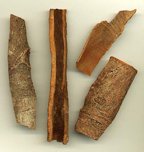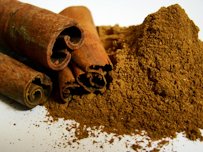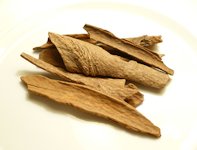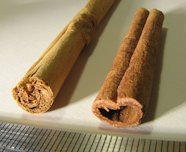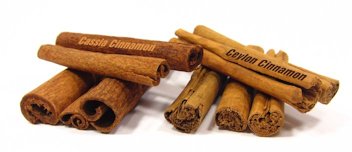How to Identify Real Cinnamon
The Difference between Cinnamomum verum and other Cinnamomum spp.
Used
as a spice for thousands of years, cinnamon comes from the bark of
various species of cinnamon trees (Cinnamomum spp). The leaves, flowers, fruits, and
roots of cinnamon trees have also been used in cooking and for
medicinal purposes. There are differences in the chemical composition
of cinnamon products produced from different species or parts of
cinnamon trees. 3
Types of cinnamon
According
to the physical location and chemical characteristics, cinnamon is
divided into few main categories. There are significant physical and
scientific differences among them. But, all of those different
varieties are commonly available in the global market as
‘cinnamon’.
Ceylon cinnamon (True/ Pure cinnamon) – Cinnamomum zeylanicum syn. Cinnamomum verum, Cinnamomum zeylanicum blume
Cassia
• Chinese cassia (Chinese cinnamon) – Cinnamomum cassia syn. C. aromaticum
• Indonesian cassia (Korintje Cinnamon) – Cinnamomum burmannii
• Vietnamese cassia (Saigon/ Vietnamese cinnamon) – Cinnamomum loureiroi
Ceylon
cinnamon and Cassia are the main types traded in the international
market under the term of ‘Cinnamon’. Both are belonging to
the family Lauraceae. Cassia cinnamon contains different sub varieties
and comes from different countries. Chinese cassia, Vietnamese cassia
and Indonesian cassia are the major spices belongs to the term of
‘Cassia’.6
Ceylon cinnamon (C. verum),
grown primarily in Sri Lanka, is known as “true” cinnamon.
Commercial true cinnamon sticks (quills) - as well as cinnamon extract
and cinnamon oil - are derived from the bark of C. verum. 1
Ceylon
Cinnamon is soft and crumbly with a subtle sophisticated and slightly
sweet taste with hints of citrus and clove. Very aromatic when boiled
or brewed. Unlike the Cassia cinnamon which is what is available at
your local grocery store. Ceylon cinnamon is called " True Cinnamon " because it is unique and native to the tiny Indian Ocean
Island of Sri Lanka. 2
Cassia cinnamon (C. aromaticum, syn. C. cassia), grown in southeastern Asia, is the most common type sold in North America. 3
It is common for Chinese cinnamon - also known as cassia cinnamon (Cinnamomum cassia)
- to be disguised as true cinnamon. Cinnamon supplements and ground
cinnamon are also often sold as a combination of true cinnamon and
cassia cinnamon. This is because true cinnamon is more expensive,
rarer, and highly preferred by chefs and bakers. For these reasons, it
can be difficult to identify it; however, certain characteristics will
help distinguish it from its Chinese counterpart. 1
Indonesian cinnamon, Padang cassia (C. burmanni).
This variety is cultivated in West Sumatra and western Jambi province
in Indonesia. This is the most common and cheapest variety available in
the US market. The leaf oil of this type does not contain eugenol.
Saigon cinnamon (C. loureiroi) is more closely related to cassia (C. cassia) than to Ceylon cinnamon (C. verum),
though in the same genus as both. Saigon cinnamon has 1-5% essential
oil content and 25% cinnamaldehyde in essential oil. Consequently,
among the species, Saigon cinnamon commands a relatively high price. 5
Quills/Bark
Ceylon cinnamon sticks are soft, crumbly and rolled like cigar with layers of
soft brittle cinnamon bark. True cinnamon has
slender, thin quills with smooth surfaces. 1
Ceylon
cinnamon, using only the thin inner bark, has a lighter brown colour
and a finer, less dense, and more crumbly texture. It is subtle and
more aromatic in flavour than cassia and it loses much of its flavour
during cooking. 5
Chinese cinnamon (C. aromaticum, syn. C. cassia)
is generally medium to light reddish-brown in colour, hard and woody in
texture, and thicker 0.079–0.118 in. (2–3 mm thick). 5
Indonesian cinnamon (C. burmanni) is often sold in neat quills made up of one thick layer (Fig. 2), capable of damaging a spice or coffee grinder. 5
Saigon cinnamon (C. loureiroi) (Fig. 3) and Chinese cinnamon (C. cassia) (Fig. 1) are always sold as broken pieces of thick bark, as the bark is not supple enough to be rolled into quills. 5
Flavor
The
flavor of real cinnamon is milder and sweeter than cassia, which is
known for having a spicy, slightly harsh taste. 1
Ingredients
The
essential oils of real cinnamon and cassia vary based on their main
active ingredient. The main active ingredient in cinnamon essential oil
is eugenol, while that of cassia is cinnamaldehyde. 1
Toxicity - coumarin
The amount of coumarin in true cinnamon (C. verum)
is so low that it has been deemed safe; however, according to the
German Federal Institute for Risk Assessment, one teaspoon of cassia,
or Chinese cinnamon (C. aromaticum, syn. C. cassia), powder contains 5.8-12.1 mg of coumarin. If
taken in high doses over a long period of time, it can cause liver and
kidneys damage. This level of cinnamon toxicity can cause uncomfortable
but reversible symptoms, such as mild dizziness, diarrhea, and vomiting. 1
Coumarin content gr/kg 2
Ceylon cinnamon (C. verum) 0.017 g/kg
Chinese cinnamon( C. aromaticum, syn. C. cassia) 0.31 g/kg
Indonesian cinnamon (C. burmanni) 2.15 g/kg
Saigon cinnamon (C. loureiroi) 6.97 g/kg
Coumarin
as an additive or as a constituent of tonka beans or tonka extracts is
banned from food in the United States due to its potentially adverse
side effects. However, coumarin in food from other natural ingredients
is not regulated. “True Cinnamon” refers to the dried inner
bark of Cinnamomum verum. Other cinnamon species, C. cassia, C. loureiroi, and C. burmannii,
commonly known as cassia, are also sold in the U.S. as cinnamon. In the
present study, coumarin and other marker compounds were analyzed in
authenticated cinnamon bark samples as well as locally bought cinnamon
samples, cinnamon-flavored foods, and cinnamon-based food supplements
using a validated UPLC-UV/MS method. The experimental results indicated
that C. verum bark contained only traces of coumarin, whereas barks from all three cassia species, especially C. loureiroi and C. burmannii,
contained substantial amounts of coumarin. These species could be
potential sources of coumarin in cinnamon-flavored food in the U.S.
Coumarin was detected in all locally bought cinnamon, cinnamon-flavored
foods, and cinnamon food supplements. Their chemical profiles indicated
that the cinnamon samples and the cinnamon in food supplements and
flavored foods were probably Indonesian cassia, C. burmannii. 4
Fig. 1. Chinese cassia or Chinese cinnamon (C. cassia, syn. aromaticum) bark
Fig. 2. Indonesian cinnamon, Padang cassia (C. burmanni)
Fig. 3. Saigon cinnamon (C. loureiroi) bark purchased from The Spice House, United States
Fig. 4. Ceylon cinnamon (C. verum) and Indonesian cinnamon (C. burmannii) sticks (quills) side by side, C. verum on the left
Fig. 5. Chinese cinnamon (C. cassia) and Ceylon cinnamon (C. verum)
|
|
Bibliography
1 HerbaZest Editorial Team. "Ceylon: The Real Cinnamon." HerbaZest, 10 Feb. 2022, www.herbazest.com/herbs/cinnamon/ceylon-the-real-cinnamon. Accessed 21 Sept. 2022.
2 "Authentic Ceylon cinnamon." Cinnamon Vogue, www.cinnamonvogue.com. Accessed 21 Sept. 2022.
3 "Cinnamon." Office of Dietary Supplements (ODS), National Institutes of Health (NIH), Public Domain, www.nccih.nih.gov/health/cinnamon. Accessed 21 Sept. 2022.
4
Yan-Hong Wang, et al. "Cassia Cinnamon as a Source of Coumarin in
Cinnamon-Flavored Food and Food Supplements in the United States." Journal of Agriculture and Food Chemestry, 2013, 61, 18, 4470–447612, Apr. 2013, ACS Publications, doi.org/10.1021/jf4005862. Accessed 21 Sept. 2022.
5 "Cinnamon." Wikipedia, en.wikipedia.org/wiki/Cinnamon. Accessed 21 Sept. 2022.
6 "Pure Ceylon Cinnamon." True Ceylon Spices, www.trueceylonspices.com/ceylon-cinnamon/. Accessed 22 Oct. 2022.
Photographs
Fig. 1 User Chaojoker. "Dried cassia bark." Wikimedia Commons, 5 Jan. 2012, GFDL, (CC BY-SA 3.0), commons.wikimedia.org/wiki/File:Cassia_bark.jpg. Accessed 21 Sept. 2022.
Fig. 2 bogdanici. "Cinnamomum burmannii - Indonesian cinnamon." Deviant Art, 28 Sept. 2008, (CC BY-NC-ND 3.0), www.deviantart.com/bogdanici/art/Cinnamomum-burmannii-99206347. Accessed 21 Sept. 2022.
Fig. 3 Badagnani. "Saigon Cinnamon bark purchased from The Spice House, United States." Wikimedia Commons, 3 Feb. 2008, (CC BY 3.0), commons.wikimedia.org/wiki/File:Saigoncinnamon.jpg. Accessed 21 Sept. 2022.
Fig. 4 Vähä-Sipilä, Antti. "Ceylon cinnamon (Cinnamomum verum) and Indonesian cinnamon (Cinnamomum burmannii) sticks (quills) side by side, Cinnamomum verum on the left. Scale shows millimetres." Wikimedia Commons, 3 Jan. 2007, (CC BY-SA 1.0 FI), commons.wikimedia.org/wiki/File:Cinnamomum Verum vs Cinnamomum Burmannii.jpg. Accessed 21 Sept. 2022.
Fig. 5 Cinnamon Vogue. "Cassia and Ceylon Cinnamon." Flickr, 3 Sept. 2012, (CC BY-SA 2.0), Image cropped, www.flickr.com/photos/cinnamonvogue/7927731106/in/photostream/. Accessed 21 Sept. 2022.
Published 22 Oct. 2022 LR
|
